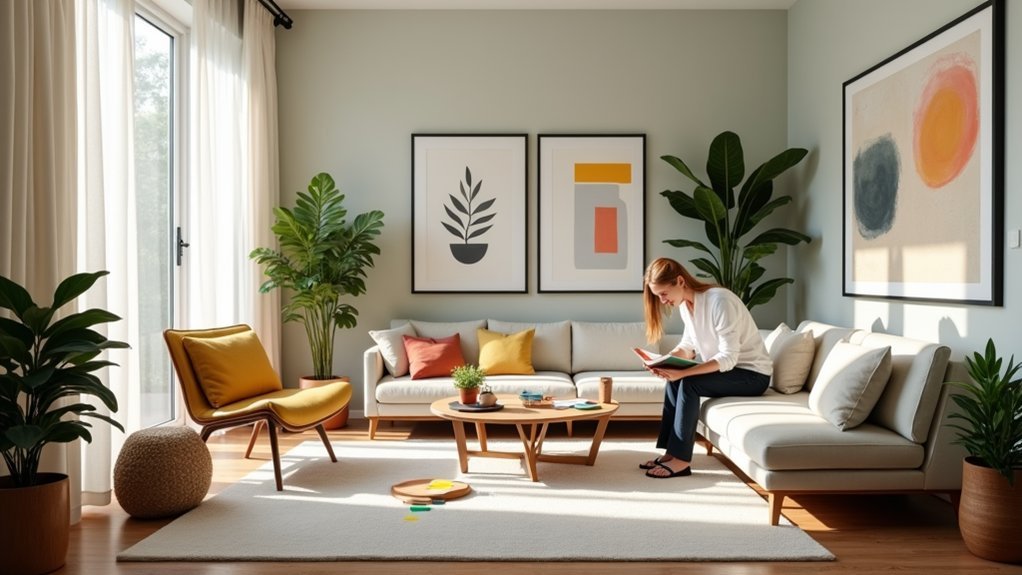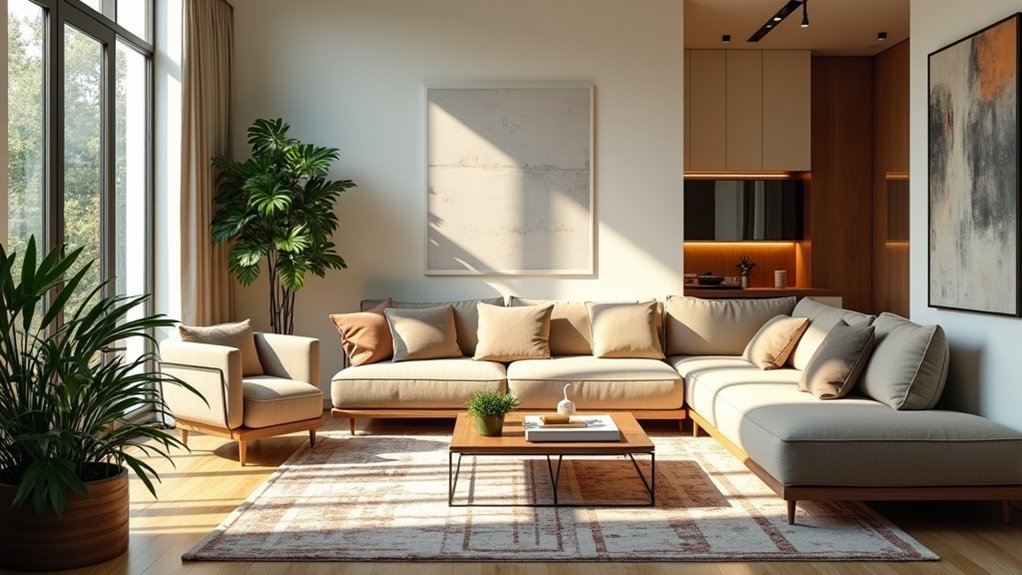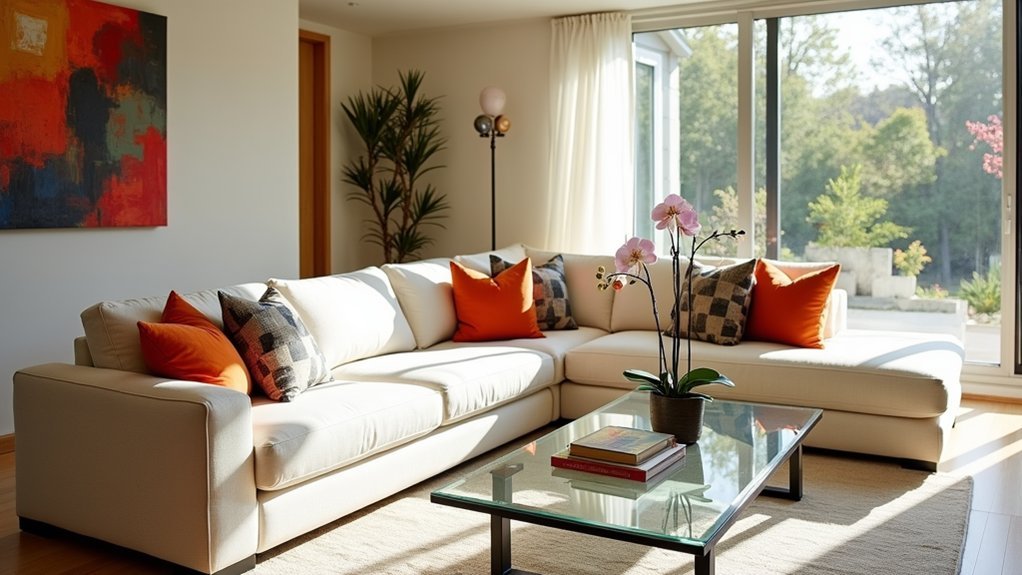Interior design offers a promising career path for those passionate about blending creativity with functionality. Designers create appealing and efficient spaces, adapting to trends in sustainability and technology. As the field presents challenges like managing budgets and client expectations, it provides opportunities for impactful work and career growth. The profession is projected to grow by 4% in the next decade, with a median salary of $62,510. Curious individuals can discover more about the rewards and challenges within this dynamic field.
Key Takeaways
- Interior design offers a creative and flexible career with opportunities to impact clients’ lives through space transformation.
- The industry anticipates a 4.0% growth over the next decade, providing job stability and new opportunities.
- Specializing in trends like sustainable design can enhance job prospects and earning potential.
- A strong foundation in education and skills like CAD proficiency and communication is essential for success.
- Challenges include managing client expectations and budgets, but certifications and networking can enhance career growth.
Is Interior Design a Good Career Path? Let’s Explore

A career in interior design involves creating functional and aesthetically pleasing environments for a variety of spaces, such as homes, offices, and public places. Professionals in this field balance creativity with practicality, often working closely with architects, engineers, and clients to guarantee designs meet both aesthetic and functional needs. As technology and sustainability become increasingly important, interior designers are adapting by integrating innovative materials and energy-efficient solutions into their projects. The demand for interior designers is influenced by economic fluctuations, and those with formal training or experience in green/energy-efficient design have enhanced employability. Many designers feel a natural talent for the field, which helps them navigate the challenges and rewards associated with their work.
What does a career in Interior Design involve?
A career in interior design involves a variety of responsibilities that center around creating functional and attractive spaces for clients. Interior designers must possess skills in space planning, color coordination, and material selection, in addition to maintaining strong communication abilities to collaborate with clients and other professionals. Success in this field requires staying updated on industry trends and building codes, along with managing project budgets and timelines effectively. Many interior designers begin their careers by working as a design associate under established designers, which allows them to handle projects and gain valuable experience in the field. Sustainable design is increasingly becoming a focal point in interior design, reflecting the trend towards environmentally friendly and eco-conscious solutions.
Common responsibilities in Interior Design
Interior design involves a blend of creativity and practicality, where professionals are tasked with transforming spaces to meet both aesthetic and functional needs. They utilize design software for drafting concepts and engage in project collaboration with architects and contractors. Responsibilities include evaluating space usage, managing project budgets, selecting materials, and ensuring compliance with regulations. Effective client communication and overseeing project execution are likewise crucial duties. Interior designers often have to interpret and translate customer needs into design plans, ensuring that the final outcome aligns with the client’s vision and requirements. An essential aspect of the profession is overseeing safety considerations in design, ensuring that spaces are not only beautiful and functional but also safe for occupants. Interior designers play a crucial role in enhancing functionality and the visual appeal of spaces, contributing significantly to the overall ambiance and energy of environments. By understanding textiles, colors, and materials, they can create spaces that are both visually appealing and tailored to the specific preferences and needs of their clients.
Required skills for success
When considering a career in interior design, awareness of the required skills is crucial for success. Interior designers must excel in creative collaboration and design innovation. They need a strong grasp of color theory, CAD proficiency, and a comprehension of building codes. Soft skills like communication and time management, along with business acumen in budgeting and project management, are equally important for thriving in this dynamic field. Problem-solving skills are also essential for navigating complex design challenges and meeting client needs effectively. Additionally, staying updated with the latest trends in the industry is essential for maintaining relevance and fostering innovation.
Is There Demand for Interior Design Professionals?
The demand for interior design professionals is shaped by evolving industry trends and a stable job market outlook. As the U.S. market anticipates a 4.0% growth over the next decade, factors like population growth, urban development, and technological advancements contribute to increased opportunities. This growth trajectory has parallels with other fields, such as exploring a career in sales, where market expansion and innovation play crucial roles. With a growing appreciation for design expertise and the expansion of design firms, interior designers find themselves well-positioned to meet the needs of both residential and commercial sectors. Notably, 79.0% of interior designers are women, highlighting a significant gender presence and influence within the industry. The field offers opportunities for entrepreneurship, allowing designers to start their own businesses and take on projects independently, which further enhances the career’s appeal. Furthermore, the total number of interior design firms is expected to surpass 17,500 in 2023, indicating a robust and expanding industry landscape.
Industry trends shaping Interior Design careers
How are industry trends shaping the career path of an interior designer? Current trends greatly influence interior design careers, particularly through the emphasis on sustainable materials and design specializations. Consumers increasingly demand eco-friendly solutions, prompting interior designers to incorporate natural materials like stone, wood, and clay into their projects. This trend not only aligns with global sustainability goals but also improves the aesthetic and functional appeal of spaces.
Interior design specializations offer professionals opportunities to focus on areas like corporate, hospitality, or residential projects. Specializing in niches such as kitchen or bathroom design is gaining traction, catering to specific client needs.
| Trend | Impact on Career Paths |
|---|---|
| Sustainable Materials | Increased demand for eco-friendly designs |
| Design Specializations | Opportunities in niche markets |
| Residential Trends | Revival of classic and cozy designs |
Job market outlook for Interior Design
Interior design professionals face a job market with moderate growth prospects, as the industry is projected to expand by 4% through 2033. This growth aligns with the average for all occupations, resulting in around 8,400 new jobs, including roles for retiring designers. Economic factors, such as consumer spending, influence market trends in demand for these professionals. Specialization in green design or technology integration can improve job growth opportunities. With the increasing importance of web development, designers who incorporate tech-savvy solutions into their projects may find enhanced career prospects. As the industry is concentrated in states like California and Texas, job prospects vary based on local conditions. In states such as Hawaii and Arkansas, there is a significant increase in job growth, highlighting the importance of location in career planning. Competition remains significant, with career advancement benefiting from certification and expertise in specific areas. The rise of coworking spaces and evolving workplace environments similarly creates new avenues for skilled designers.
Benefits of Working in Interior Design

People often choose a career in interior design due to it offering a unique blend of creative expression and professional flexibility. This field allows individuals to explore artistic talents while providing the autonomy to select projects and work environments that suit their personal and professional goals. Furthermore, the potential for economic growth and job satisfaction makes interior design an appealing option for those seeking a fulfilling career path. With the growing industry demand, designers have the opportunity to impact clients’ lives significantly through the transformation of their spaces. According to recent reports from ASID, employee expectations such as work flexibility and wellness benefits are increasingly valued, enhancing the attractiveness of careers in interior design.
Why people choose Interior Design as a career
Interior design is a career that attracts individuals because of its key advantages, such as the ability to express creativity and the satisfaction of transforming spaces. The field additionally offers long-term growth potential, with opportunities for career advancement and specialization in various sectors. As the demand for innovative and sustainable design solutions increases, interior designers can enjoy a robust job market and the chance to make a meaningful impact on clients’ lives. Moreover, the diverse projects that interior designers work on ensure that there is no monotony in their work, keeping the profession engaging and dynamic.
Key advantages of working in Interior Design
Creativity stands at the forefront of the advantages of pursuing a career in interior design. It offers an artistic outlet for creative inspiration, allowing designers to transform spaces through design psychology. Visionary projects and style development enable personal expression. Additionally, the career path in interior design is growing, with salaries ranging from INR 3,00,000 to 9,00,000, which reflects the increasing demand and opportunities within the field. Furthermore, flexible schedules, diverse client bases, and varied project opportunities provide continuous challenges and learning, contributing to personal fulfillment and professional satisfaction.
Long-term growth potential
As creativity fuels the passion for interior design, the potential for long-term growth in the industry is an equally compelling reason to pursue this career path.
The growth of 4% through 2033 is driven by:
- Increasing demand for sustainability practices and energy-efficient designs.
- Advancements in design technologies enhancing creative processes.
- Opportunities arising from retirements, creating space for new talents.
Challenges of a Career in Interior Design
Interior design presents several challenges that professionals must navigate to succeed in the field. Managing demanding clients with varied expectations, dealing with limited budgets, and maintaining strong customer service skills are crucial aspects of the job. Moreover, staying updated with industry trends and regulatory requirements is critical for career growth and ensuring creative expression within the constraints of each project. Additionally, developing effective communication skills is essential for resolving conflicts that may arise during the design process, ensuring a harmonious and productive working relationship with clients and team members.
Common difficulties in Interior Design
Entering the interior design field presents significant barriers, with the job market being particularly competitive because of minimal projected growth.
Aspiring designers often face challenges such as gaining practical experience and building a robust professional portfolio, which are crucial for attracting clients and employers.
Furthermore, the need to continuously update skills and knowledge to stay relevant in the industry further intensifies the competitive environment.
Additionally, developing important productivity skills can significantly enhance an interior designer’s efficiency and effectiveness, aiding in managing multiple projects and deadlines.
Barriers to entering Interior Design
Breaking into the field of interior design presents various challenges that aspiring designers must navigate.
Barrier solutions like mentorship programs can help overcome hurdles such as:
- Lack of Practical Experience: Many face the challenge of gaining experience without a job.
- High Educational Requirements: Significant education is needed to become licensed.
- Limited Access to Mentorship: Racialized communities often lack mentors and supportive networks.
How competitive is the job market?
Aspiring interior designers, having navigated initial barriers to entry, must likewise face a competitive job market. The job market competitiveness stems from steady growth, with a 4.0% increase expected by 2032, and the rise of technology enhancing design processes. Interior design challenges include managing client expectations, adapting to regional demands, and collaborating with professionals. Success hinges on strong communication and customer service skills. Adapting to evolving workforce demands is crucial, as adaptability skills are essential for success in a changing job market.
How to Start a Career in Interior Design

To start a career in interior design, individuals often begin with formal education, such as a bachelor’s degree, which provides foundational knowledge in both design and business aspects. Gaining practical experience through internships, job shadowing, or online courses can be essential steps to build skills and create a strong portfolio. Certifications like the NCIDQ can further improve career prospects, opening doors to specialized roles and advancement opportunities in the field. Creating a personal development plan is essential for career growth and advancement, providing a structured approach to enhance motivation and direction in career planning.
Education and training requirements
To begin a career in interior design, obtaining relevant certifications can improve professional credibility and open doors to career advancement.
The NCIDQ certification is widely recognized and often required for licensure in various states, highlighting a designer’s commitment to industry standards.
Furthermore, those interested in specialized areas such as kitchen and bath design can pursue certifications like the NKBA to further demonstrate expertise in these niches.
Recommended certifications for Interior Design
A career in interior design benefits greatly from obtaining relevant certifications, which can improve a designer’s credentials and open up more career opportunities. Certifications provide crucial validation of skills and knowledge, often through professional organizations. Recommended certifications include: 1. NCIDQ Exam: Crucial for professional certification. 2. CIDI Certification: Offers credentials for decorators. 3. Online Certification Courses: Augment skills and industry knowledge. Developing soft skills such as communication and teamwork can further enhance a designer’s career by fostering better client relationships and project collaboration.
How to gain experience in Interior Design
Starting a career in interior design often begins with gaining the right experience, which is crucial for standing out in this creative field. Individuals can explore internship opportunities to work alongside established designers, allowing them to learn industry skills and build a professional portfolio. Participating in design competitions can likewise improve one’s credentials, providing recognition and feedback from experts. Engaging with remote industry associations can enhance visibility and create new opportunities for career growth. Practical experience is fundamental, and volunteering for design projects offers further exposure. Building a cohesive portfolio showcasing various design styles is crucial. Networking within the industry and establishing connections can open doors to job opportunities, making it easier to navigate the competitive terrain of interior design.
Salary & Career Growth in Interior Design
Interior design offers a promising career with a median annual wage of $62,510 as of May 2023, though earnings can vary widely based on experience, location, and industry.
Career advancement opportunities are present, with job growth projected at 4% from 2023 to 2033, aligning with the average for all occupations.
The field likewise provides flexibility with options for self-employment and specialization in various sectors such as residential, commercial, and sustainable design.
Average salary for Interior Design professionals
The average salary for interior design professionals varies widely, influenced by factors such as industry, experience, and certifications. Many designers begin their careers with modest earnings, typically around $30,000 annually.
Nevertheless, with experience and effective salary negotiation, they can see significant increases, with potential earnings reaching up to $90,000 or more after two decades. Freelance opportunities likewise allow for a flexible income stream, with earnings dependent on client base and project scope.
- Experience and Industry: New designers may earn $31,971, whereas those in architecture and engineering average $63,210.
- Certification Benefits: NCIDQ certification holders enjoy higher median salaries, around $55,811.
- Project Type: Designers in commercial projects often earn more than those in standard residential work.
Understanding these factors can guide career decisions in interior design.
Career advancement opportunities in Interior Design
Though comprehending the potential earnings in interior design is important, exploring career advancement opportunities reveals a broader picture of growth within the field.
Interior designers can specialize in areas such as residential, commercial, or sustainable design, allowing them to develop a unique design philosophy. As they gain experience, roles like senior interior designer or design director become attainable, involving greater project collaboration and leadership.
The industry likewise offers positions like partner or principal, which come with significant responsibilities and earning potential. Transferable skills in interior design open doors to related fields, like industrial design.
Career growth is supported by developing project management skills, building client relationships, and networking. Exploring project management as a career choice can further enhance an interior designer’s ability to manage complex projects efficiently, leading to increased opportunities. Continuous learning and specialization are key to advancing and increasing recognition within the profession.
Is Interior Design a Good Career Path? Final Thoughts

Choosing a career in interior design involves weighing both its appealing and challenging aspects.
The field offers flexibility in education and creative opportunities, yet requires continuous learning and adaptation to economic changes.
Prospective designers should consider factors like job growth potential, salary expectations, and the necessity for technical skills before initiating this career path.
Key takeaways for choosing Interior Design as a career
Why consider a career in interior design? This field offers the chance for creative expression and client collaboration, crucial for those passionate about transforming spaces.
The U.S. job market for interior designers is projected to grow by 4% over the next decade, which aligns with general occupational growth. In addition, about 8,800 openings are anticipated annually, driven by replacement needs and sector expansion.
Key takeaways include:
- Diverse Opportunities: Interior designers can work in varied settings, from design services to architectural firms, enhancing their creative impact.
- Required Skills: Success in this career often requires strong communication skills, proficiency in design software, and a solid educational background.
- Financial Prospects: With a median salary of $62,510, interior design offers stable financial opportunities, though income can vary widely.
Factors to consider before starting in Interior Design
Starting a career in interior design offers both opportunities and challenges that are significant to reflect upon. Aspiring designers must excel in managing design aesthetics whilst nurturing strong client relationships.
Effective communication and negotiation skills are critical for setting and meeting client expectations. Time management is imperative, as designers often handle multiple tasks under tight deadlines.
Technical proficiency in software like CAD and SketchUp is necessary to visualize ideas accurately. Moreover, balancing creativity with practical feasibility is fundamental for success.
Designers must navigate budget constraints and adapt to frequent design changes. Building a professional portfolio and maintaining a personal brand through self-promotion and networking are likewise significant.
Continuous learning and obtaining relevant certifications improve credibility and future opportunities in this dynamic field.
Frequently Asked Questions
What Educational Background Is Needed for Interior Design?
A design degree, ideally a bachelor’s, is often preferred for interior design. Certification programs offer alternative routes, providing foundational skills. Accreditation, coursework in CAD, and work experience are essential for professional growth and licensing opportunities.
How Does Interior Design Differ From Interior Decorating?
Some may assume interior design vs decorating are similar, yet their roles and responsibilities differ considerably. Interior design encompasses structural planning, safety, and technical expertise, whereas decorating focuses on aesthetics through furniture and color without structural involvement.
What Software Is Commonly Used by Interior Designers?
Interior designers commonly use design software like AutoCAD, SketchUp Pro, and Archicad for precision, flexibility, and 3D modeling. Tools like Blender and Homestyler offer cost-effective solutions, enhancing design visualization and rendering capabilities, essential in their workflow.
Are Internships Important for Aspiring Interior Designers?
Internships for aspiring interior designers are a golden bridge to career success, offering benefits like improved employability and industry networking. They provide invaluable exposure, allowing participants to apply concepts practically, boosting confidence and refining necessary skills.
What Skills Are Essential for Success in Interior Design?
Crucial skills for success in interior design include creative thinking and communication skills. These enable designers to develop innovative ideas and effectively convey them to clients, ensuring projects meet both aesthetic and functional requirements.
Conclusion
To summarize, interior design can be a rewarding career path for those with a passion for creativity and aesthetics. According to the U.S. Bureau of Labor Statistics, employment of interior designers is projected to grow 1 percent from 2019 to 2029. Although the growth rate is slower than the average for all occupations, a sharp eye for design and adaptability to evolving trends can lead to a successful career. In the end, personal dedication and skill development play crucial roles in achieving long-term success.
